Pekka Buttler, 01/2025
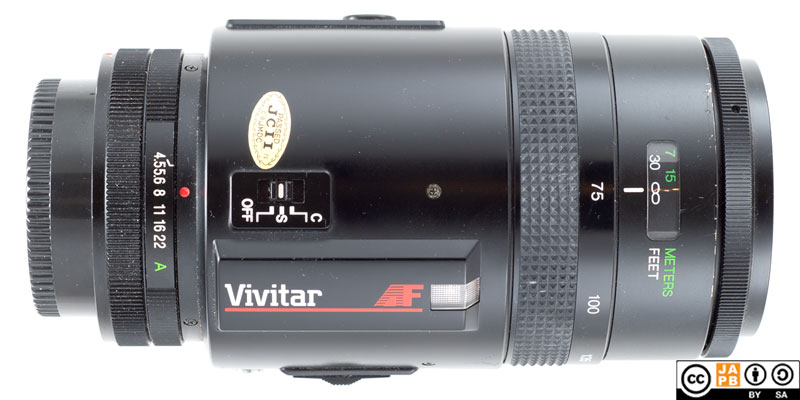
Specifications
The table below summarizes the lens’ key specifications (measurements based on pictured version of the lens):
| Brand: | Vivitar | Lens name | 75–200mm 1:4.5 MC Auto Focus Zoom |
| Focal length(s)1 | 75–200 mm | Angle-of-view2 | 32-12 ° |
| Maximum Aperture | f/4.5 | In Production | unclear3 |
| Lens mount (this lens) | Canon FD | Other lens mounts | multiple4 |
| Length5 | 137,9 mm | Diameter6 | 81,9 mm |
| Filter ring diameter | 58 mm | Weight | 612 grams |
| Lens element count | 12 | Lens group count | 9 |
| Aperture blades (S/R/C)7 | 8 S | Focus throw | 90 ° |
| Minimum focusing distance (measured) | 1,04m (@75mm) 1,08m (@200mm) | Maximum magnification (measured) | ≈1:9,9 (@75 mm) ≈1:3,9 (@200mm) |
| Has manual aperture ring | YES | Has Manual focus ring | YES |
| Aperture mechanism type | Auto | Aperture click stops8 | 4.5-5.6-8-11-16-22 |
Further notes:
• This lens is a bit of a special case: It is an autofocus lens that does not need an autofocus capable body. Thereby the lens brings autofocus capabilities to bodies and systems that – on their own – lack this ability.
• The lens accomplishes independent autofocus by means of a beam splitter to facilitate phase detect autofocus. Read more on the topic in the JAPB article on autofocus technologies.
• To facilitate autofocusing, the lens needs internal batteries (3xAAA); the autofocusing is activated by pressing a button on the side of the lens barrel.
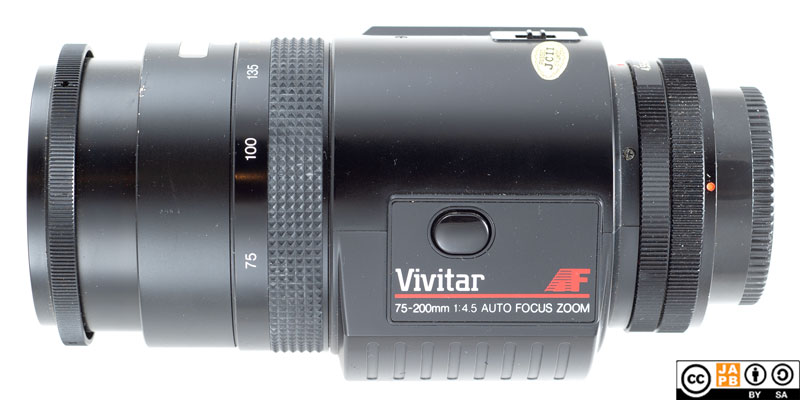
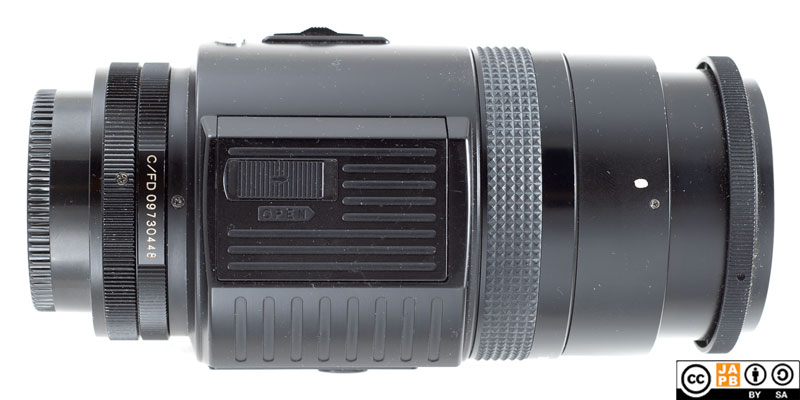
• Obviously autofocus speed and accuracy are by no means on the level of modern marvels, but compared to some of the other 1st generation AF cameras the focus speed is not entirely impossible. Also – like many 1st Gen AF bodies – the AF system’s ability to find focus necessitates a fair bit of light.
• The Autofocus system has three settings: Off, S (Single shot) and C (continuous focus). The lens also has a switch for choosing between M (manual focus) and AF (autofocus). Importantly, when that switch is set to AF, trying to manually focus the lens may lead to breakage.
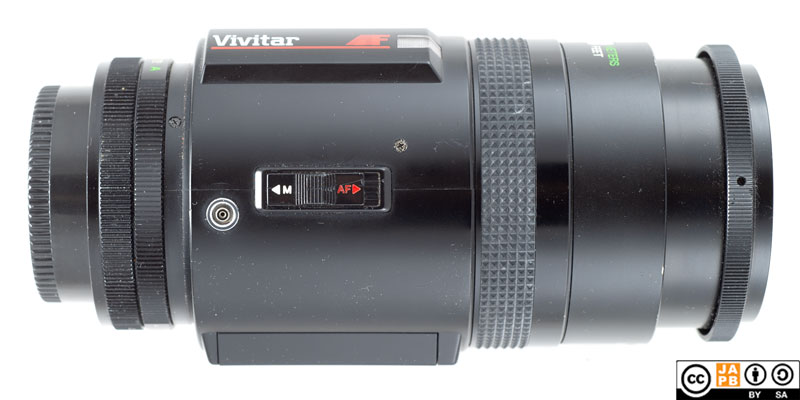
• This lens was manufactured by Cosina. Cosina sold this lens under their own brand, but also offered it for sale to Vivitar [this lens] 9.
• The lens uses an internal zooming design, meaning that the length of the lens does not change on zooming.
• Somewhat less impressive is that the whole front-part of the lens (including filter threads) rotate while focusing.
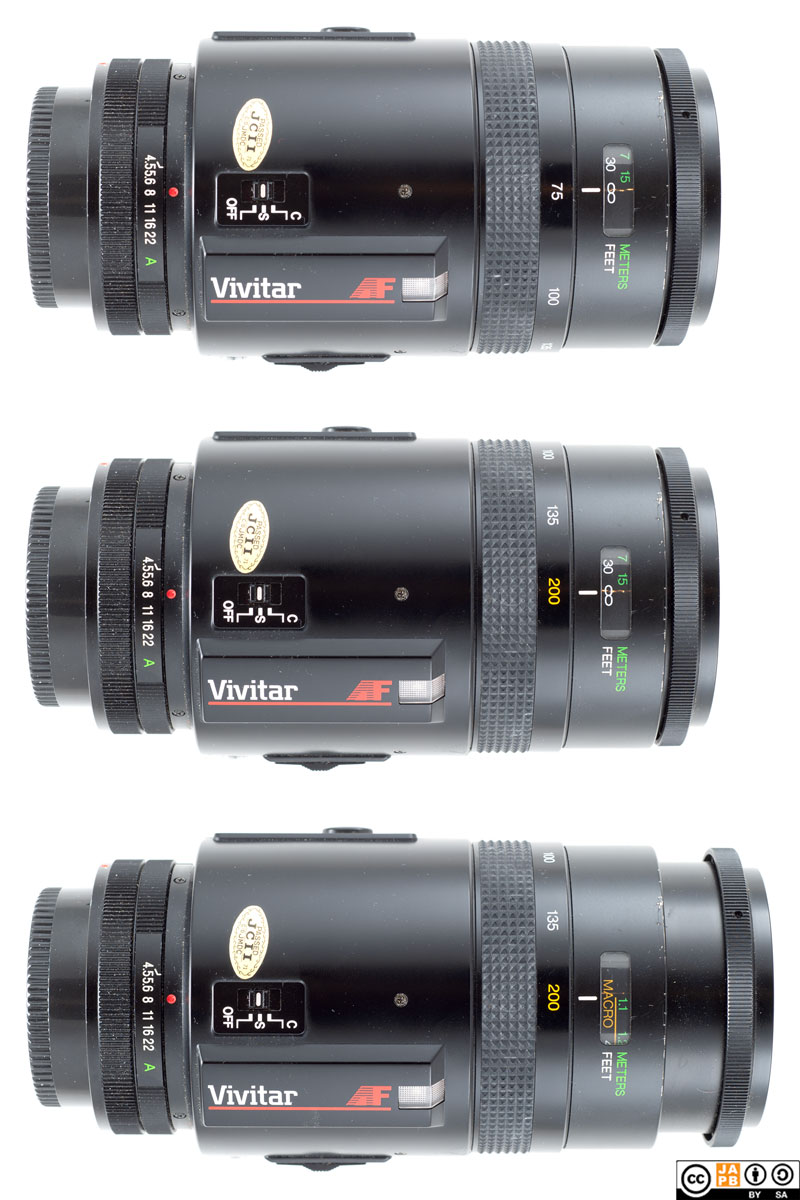
Top: Zoomed to 75 mm, focused at infinity
Middle: Zoomed to 200 mm, focused at infinity
Bottom: Top: Zoomed to 200 mm, focused at MFD
Versions and variations
There are two known versions of this lens: This (Vivitar-branded) version that has one autofocus button as well as an otherwise identical (Cosina-branded) lens with two autofocus buttons (one labeled ‘W’ and the other ‘T’)
History of Vivitar
Vivitar initially was the trade name used by Ponder & Best Inc. until Ponder & Best changed its name to Vivitar Corp. From the 1960s to the early 2000s the company contracted various (mostly Japanese) optical and electronics manufacturers to manufacture photographic gear to be branded as Vivitar.
You can read more details in the Vivitar company profile.
Adapting
n.B! The following applies to all Canon FD mount lenses. Should you have the Vivitar (or Cosina) autofocus telezoom in another mount, please see the JAPB guide of the respective, other lens mount.
This lens cannot be used natively on any current SLR or dSLRs. To use it in its native environment, you will need a Canon FD or FDn-mount film body.
Thanks to being a fully manual lens (manual aperture, manual focus), the lens can be adapted to all mirrorless cameras using a suitable adapter. However, for the adapter to allow the lens to stop down, you will need an adapter that can be set to engage the FD lens’ aperture control lever. Personally, this is my biggest gripe with the FD-mounts as this leads to what I refer to as the four-ring problem:
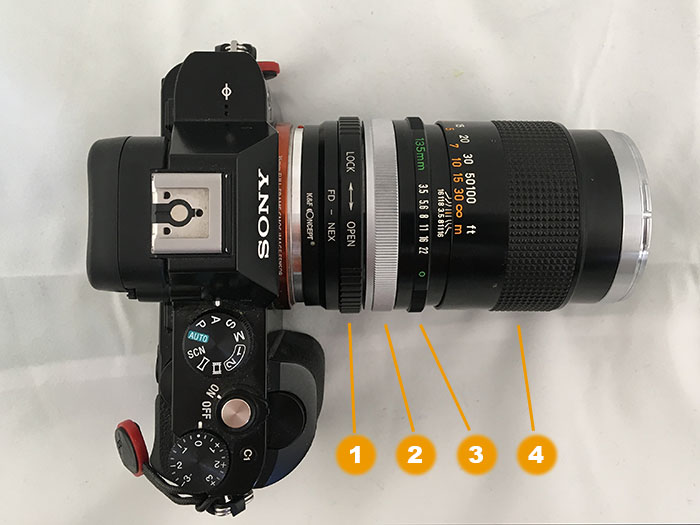
[1] Activation ring for aperture control
[2] Locking ring for breech-lock mount
[3] Aperture ring
[4] Focus ring
Note, that especially the first three rings are very close together.
Moreover, a large range of special adapters (helicoid adapters, tilt/shift adapters, speed boosters) for using Canon FD lenses on most mirrorless systems are available.
Using Canon FD lenses on dSLRs is a possibility, but is not problem free. Thanks to the relatively short flange focal distance of the Canon FD mount (at 42,0 mm, clearly shorter than that of any full-frame dSLR mount), any adapter will necessitate some corrective optics to achieve infinity focus.
Footnotes
- Focal length is (unless stated otherwise) given in absolute terms, and not in Full-frame equivalent. For an understanding of whether the lens is wide/tele, see ‘Angle-of-view’. ↩︎
- Picture angle is given in degrees (based on manufacturers’ specs) and concerns the diagonal picture angle. Rule of thumb:
> 90 ° ==> Ultra-wide-angle
70–90 ° ==> Wide-angle
50–70 ° ==> Moderate wide-angle
40–50 ° ==> ‘Standard’ or ‘normal’ lens
20–40 ° ==> Short tele lens
10-20 ° ==> Tele lens
5-10 ° ==> Long tele lens
< 5 ° ==> Ultra-tele lens ↩︎ - Existing information is very sparse, likely introduced late 80s.. ↩︎
- Including: Contax/Yashica, M42, Minolta SR, Nikon F, Olympus OM and Pentax K ↩︎
- Length is given from the mount flange to the front of lens at infinity. ↩︎
- Diameter excludes protrusions such as rabbit ears or stop-down levers. ↩︎
- S=straight; R=rounded; C=(almost)circular at all apertures. ↩︎
- Numbers equal aperture values on aperture ring; • intermediate click; – no intermediate click. ↩︎
- Some online sources mention that the same Cosina design was also sold by some of the ‘usual suspect’ rebranders (specifically Soligor, Rokinon and Exakta are sometimes named). However, because JAPB is not in the business of uncritically repeating internet legends, this detail is left to a footnote. ↩︎